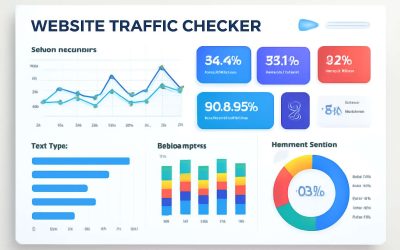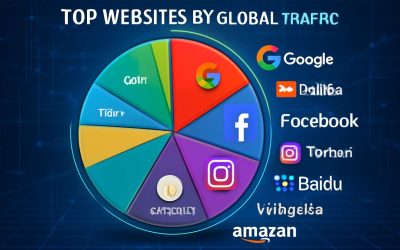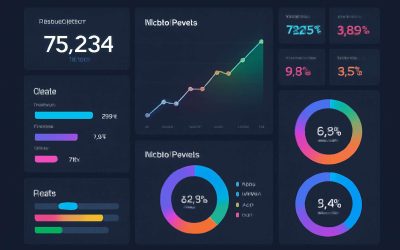Understanding Website Traffic in Digital Marketing
What Is Website Traffic?
In the vast, swirling ocean of digital interaction, understanding what is website traffic in digital marketing becomes an essential compass for navigating success. It’s not merely the number of visitors that arrive at a website, but the intricate dance of human curiosity, intent, and engagement that these numbers reveal. Each click, each pause on a page, whispers a story about audience interests and behaviour, propelling brands to refine their digital presence with precision and purpose.
At its core, website traffic encompasses the volume and quality of visits a site receives, but it extends far beyond raw figures. It’s about deciphering patterns—when do visitors arrive? How long do they stay? Which pathways do they follow? This layered understanding transforms simple data into strategic insight, allowing marketers to craft more compelling, targeted experiences. To deepen this understanding, it’s worth considering the different types of traffic:
- Organic: Visitors arriving through unpaid search results, driven by relevance and content quality.
- Paid: Traffic generated through targeted advertising campaigns, often with measurable ROI.
- Referral: Visitors coming from other websites, indicating the value of link-building and partnerships.
By exploring what is website traffic in digital marketing, businesses unlock the key to cultivating a vibrant, engaged audience that not only visits but also interacts meaningfully, transforming fleeting visits into lasting relationships. After all, in this digital age, traffic isn’t just numbers—it’s the heartbeat of online presence and growth.
Importance of Website Traffic in Digital Marketing
Understanding website traffic in digital marketing is akin to recognising the pulse of your online presence. It’s not merely about tallying visitors; it’s about interpreting the subtle cues that reveal audience intent and engagement. When you grasp how traffic flows and evolves, you gain the power to refine your digital strategies with finesse and purpose.
The real importance of website traffic in digital marketing lies in its ability to serve as a mirror reflecting your audience’s preferences and behaviours. For instance, monitoring the types of traffic—be it organic, paid, or referral—can illuminate which channels are most effective. A simple
- increase in organic visitors
- successful paid campaigns
can signal that your content resonates or your advertising hits the mark.
In essence, understanding what is website traffic in digital marketing allows brands to craft more compelling stories and experiences, turning fleeting visits into loyal relationships. After all, without this comprehension, navigating the online landscape becomes a game of chance rather than strategic mastery.
Types of Website Traffic – Array
Understanding website traffic in digital marketing reveals more than just numbers; it uncovers the story behind visitor behaviour. Various types of website traffic paint a detailed picture of how audiences engage with your brand. Organic traffic, driven by search engines, often signifies content relevance and visibility. Paid traffic results from targeted advertising campaigns that boost your reach swiftly. Referral traffic flows in from other websites, acting as endorsements that expand your audience base.
The complexity of website traffic lies in recognising these distinct channels and their impact. For example, a sudden spike in organic visitors might indicate successful SEO efforts, while increased referral traffic can reveal valuable partnerships. By analysing these different types, marketers can fine-tune strategies, ensuring that every visitor counts and contributes to long-term growth. Understanding what is website traffic in digital marketing is not just about monitoring; it’s about interpreting the signals that guide your journey through the digital landscape.
Metrics to Measure Website Traffic
Key Performance Indicators (KPIs) – Array
In the vast realm of digital marketing, understanding what is website traffic in digital marketing is only the beginning; the true alchemy lies in deciphering the metrics that reveal its secrets. These key performance indicators (KPIs) serve as enchanted mirrors, reflecting the true health of your online presence. By analysing data such as page views, bounce rates, and session durations, marketers can gauge the allure and engagement of their digital domain.
For instance, a surge in unique visitors often signals that your content resonates profoundly with your target audience. Conversely, a high bounce rate may whisper of elusive content or an unfavourable user experience. To navigate these waters with precision, some organisations rely on a constellation of KPIs, including:
- Average session duration
- Pages per session
- Conversion rate
- Traffic sources
Each metric acts as a vital rune, guiding decisions and illuminating the path to optimisation. When viewed collectively, they transform raw numbers into a narrative — one that tells the story of your digital odyssey and its trajectory through the bustling cyber cosmos. Truly, knowing what is website traffic in digital marketing is but the first step in mastering the art of digital enchantment.
Tools for Tracking Website Traffic – Array
In the shadowy corridors of digital marketing, knowing what is website traffic in digital marketing is only half the story; the true power lies in the tools that unveil its secrets. These metrics act as lanterns in the gloom, illuminating the unseen currents that shape your online presence. To grasp the flow of visitors, marketers turn to specialised tracking tools that reveal the intricate dance of user behaviour and engagement.
Among the most revered instruments are web analytics platforms like Google Analytics, which serve as a digital crystal ball. They offer a treasure trove of insights, from real-time visitor counts to behavioural patterns. With these tools, one can measure:
- Source of traffic—are visitors arriving via organic search, social media, or paid campaigns?
- Geographical location—where do your visitors come from in the vast digital realm?
- Device and browser data—are they accessing your site through mystical mobile devices or arcane desktop browsers?
Each metric, each data point, weaves together a narrative—an intricate tapestry revealing the true essence of your digital domain. When used with a keen eye, these tools become enchanted keys, unlocking the hidden pathways to optimisation and mastery over what is website traffic in digital marketing.
Strategies to Increase Website Traffic
Content Marketing
Understanding how to boost what is website traffic in digital marketing is akin to unlocking the heartbeat of your online presence. High traffic demonstrates your content’s resonance, attracting not just visitors but potential customers eager to engage. To amplify this flow, content marketing emerges as a powerful strategy—delivering relevant, valuable material that draws audiences organically. When crafted thoughtfully, your content acts as a magnet, enticing users to explore deeper facets of your brand.
Beyond creating compelling articles and visuals, implementing targeted distribution channels can significantly elevate your website traffic. Consider leveraging social media, guest blogging, and email campaigns to broaden your reach. An often-overlooked approach is prioritising search engine optimisation (SEO), ensuring your content ranks higher in search results, which directly impacts what is website traffic in digital marketing. Remember, consistency and quality are the twin engines driving sustained growth in website visits, transforming casual browsers into loyal clients.
Search Engine Optimization (SEO)
In the grand tapestry of digital marketing, understanding what is website traffic in digital marketing is akin to deciphering the pulse that keeps your online kingdom alive. To truly elevate this heartbeat, Search Engine Optimization (SEO) becomes your most loyal ally—an alchemist transforming content into a beacon that draws visitors like moths to a flame. When executed with finesse, SEO isn’t just about rankings; it’s about weaving your brand into the very fabric of search intent, making your site a destination of choice.
One compelling strategy involves optimising on-page elements—meta descriptions, header tags, and keyword placement—all tailored to meet the subtle whims of search algorithms. Moreover, embracing a holistic approach, such as
- building authoritative backlinks
- enhancing site speed
- ensuring mobile responsiveness
, can dramatically amplify your visibility. These tactics work in concert to elevate your content’s prominence, transforming casual browsers into engaged explorers. After all, in the quest to understand what is website traffic in digital marketing, SEO is the lantern illuminating the path through the labyrinth of the digital realm.
Social Media Marketing
In the relentless pursuit to understand what is website traffic in digital marketing, one realisation becomes clear: human connection remains at its core. Social media marketing emerges as a powerful conduit in this endeavour, forging bridges between brands and audiences hungry for authenticity. When executed with intention, social media isn’t merely about posting; it’s about cultivating relationships that inspire curiosity and trust.
Strategically, harnessing social media platforms can dramatically increase website traffic by engaging users where they already dwell. Creating shareable content, fostering conversations, and leveraging targeted ads all serve as catalysts in this process. An often overlooked aspect is the human element—understanding what motivates your audience and speaking directly to that inner hunger. After all, the most effective way to boost website traffic lies in resonating deeply with human desire and curiosity, turning passive viewers into active explorers of your digital domain.
Paid Advertising Campaigns
In the intricate dance of digital presence, paid advertising campaigns can act as a catalyst to turbocharge your website traffic. When strategically executed, these campaigns not only attract a broader audience but also target specific segments hungry for your unique offerings. Understanding what is website traffic in digital marketing reveals that paid ads are a vital piece of the puzzle—an arrow in your quiver that delivers instant visibility and measurable results.
To maximise impact, consider deploying a mix of platforms—Google Ads, social media promotions, or display networks—that align with your audience’s browsing habits. An effective campaign hinges on precise audience targeting, compelling ad copy, and captivating visuals that pique curiosity. The key is engaging users at the right moment, prompting them to click and explore your digital domain.
- Define clear objectives—whether brand awareness or direct conversions.
- Refine targeting parameters—demographics, interests, behaviours.
- Monitor KPIs meticulously—click-through rates, cost per click, and bounce rates.
- Iterate relentlessly—optimise ad copy and visuals based on real-time data.
With every campaign, the mystery deepens—what is website traffic in digital marketing is not merely about numbers; it’s about understanding human motivation and harnessing that insight to guide visitors straight into your digital sanctuary. Paid advertising campaigns, when wielded with precision, transform passive viewers into active explorers—each click a step closer to unlocking your brand’s true potential.
Analyzing and Optimizing Website Traffic
Traffic Analysis Techniques
Understanding what is website traffic in digital marketing is akin to deciphering the lifeblood coursing through your business veins. It offers a window into how effectively your digital presence attracts and retains visitors, revealing hidden opportunities and silent pitfalls alike. Once you’ve identified this vital metric, the next step is to analyse it with a fine-tooth comb. Traffic analysis techniques, such as examining visitor behaviour, bounce rates, and conversion paths, can illuminate the subtle nuances behind raw numbers.
Rather than relying solely on superficial data, a more refined approach involves segmenting traffic sources and behaviour patterns. For instance, tracking which channels drive the most engaged visitors can lead to more targeted optimizations. To make sense of this labyrinth, consider employing a combination of tools and methods—ranging from heat maps to funnel analysis—each offering a different lens on visitor interactions. This layered approach transforms mere numbers into actionable insights, guiding strategic adjustments that elevate your digital marketing game.
Identifying Trends and Patterns
Understanding what is website traffic in digital marketing is akin to decoding the symphony of your online presence. Once you have a grip on this vital metric, the real art begins: analysing and optimising traffic trends and patterns. It’s far more nuanced than merely counting visitors; it involves recognising subtle shifts that signal opportunity or concern.
By tracking behavioural shifts—such as changes in page engagement or the time spent on certain content—marketers can uncover emerging trends. For example, a spike in traffic from a specific source might reveal an untapped channel or a successful campaign. Conversely, dips can illuminate silent pitfalls waiting to be addressed. To make sense of these dynamics, employing a combination of analytical methods, such as funnel analysis or heat maps, transforms raw numbers into insightful narratives. These insights serve as a compass, guiding strategic adjustments that elevate your digital marketing efficacy.
Conversion Rate Optimization
Understanding what is website traffic in digital marketing is only the start of a captivating journey. Once the numbers begin to flow, the true adventure lies in analysing and optimising conversion rates. Every visitor is a potential story waiting to unfold, but it’s the behavioural shifts—like changes in engagement or the paths visitors take—that reveal the real secrets behind your digital landscape.
By examining these patterns, marketers can identify opportunities to enhance user experience and boost engagement. For instance, a sudden increase in traffic to a specific landing page might signal a new interest or an effective campaign. Conversely, unexpected dips could point to silent pitfalls lurking within the site’s architecture.
- Identify high-performing channels and focus on amplifying their impact.
- Implement A/B testing on key landing pages to refine messaging and design.
- Utilise heat maps to gain visual insights into visitor behaviour.
These methods transform raw numbers into a compelling narrative, guiding strategic decisions that elevate your digital marketing prowess. When you truly understand what is website traffic in digital marketing, each metric becomes a vital clue on the path to optimisation and growth.
Adjusting Strategies Based on Data
Understanding how to analyse and optimise website traffic can feel like navigating a labyrinth—each twist revealing new insights and opportunities. When you grasp what is website traffic in digital marketing, you unlock the power to fine-tune your strategies with precision. Data-driven adjustments allow for a dynamic approach, where every visitor becomes an opportunity to refine your message.
Adjusting strategies based on behaviour shifts isn’t just about reacting to numbers; it’s about anticipating the next move. By leveraging tools like heat maps and behaviour analytics, marketers can uncover hidden patterns—those subtle cues that signal what truly resonates with your audience.
- Prioritise high-impact channels
- Refine messaging through A/B testing
- Identify engagement hotspots
These steps transform raw data into a narrative that guides smarter decisions, ensuring your digital landscape remains vibrant and responsive.
As the digital world evolves, so does the importance of understanding what is website traffic in digital marketing. Immersing yourself in these insights turns static numbers into a living map—an enchanted compass guiding your growth journey with clarity and purpose. Each metric, when analysed correctly, reveals a secret waiting to be uncovered—an unseen thread connecting your traffic to the ultimate success.



0 Comments